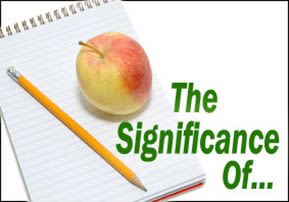
The Significance of …
What is the significance of Rosh Hashanah falling on Rosh Chodesh, the simanim (significant omens at our festive table), or the different blasts of the shofar?

Rosh Hashanah and the New Moon
There are many levels of understanding the significance of Rosh Hashanah also being Rosh Chodesh, a new moon. Every Rosh Chodesh inaugurates an entirely new energy and a new opportunity to begin again. The ability to renew and rejuvenate is one of the secrets of the Jewish calendar being based on the lunar cycle. The capacity to begin again and again lies at the very root of Jewish survival. Rosh Hashanah, the new year, is the “headquarters” for newness, thus it shares the same energy as Rosh Chodesh.
The shape of the moon on Rosh Chodesh and Rosh Hashanah is but a thin, cup like sliver, seen for a short time in the western sky before going down at sunset. The judgment taking place on Rosh Hashanah is similarly hidden, yet a sliver of the light does reach us. We can envision the shape of the moon representing our heartfelt prayers to create a vessel to receive blessings. God wants to give us so much – the question is do we have vessels to receive it.
The Midrash states that when the moon was created it complained to God that both it and the sun could not wear the same crown. Therefore God made the moon smaller. A different Midrash states that every Rosh Chodesh God – as it were – brings a guilt offering for making the moon small. Rosh Hashanah comes on a Rosh Chodesh in order to teach us that since we should not judge anyone until we stand in their place, God – so to speak – whispers to us that he empathizes with our situation and thus understands our desire for rectification and forgiveness, for He too brings a guilt offering on this day! This parable represents the judgment on Rosh Hashanah as one of understanding and compassion.
The Notes of the Shofar
There are three basic sounds of the shofar – tekiya, shevarim and teruah. In the Torah, Rosh Hashanah is actually called “Yom Teruah,” a day of sounding the shofar. The Sages in the Talmud all agreed that the teruah connotes crying, but disagreed whether it was like a melancholy moaning or a more uncontrolled staccato sound. Therefore, both opinions are honored and today we sound the shevarim, which alludes to sighing and has three medium length sounds, the teruah, which connotes uncontrollable crying comprised of nine short sounds and the shevarim-teruah, a combination of the two. Preceding and following each of these sounds is the tekiya which alludes to many things in our tradition: a summons to gather together, a wake up call, a way to greet the king, as well as a sound of joy and rejoicing.
One notices a certain inconsistency between the different crying sounds of the teruah and shevarim and the more uplifting, joyful sound of the tekiya. This paradox reflects two equally important aspects of Rosh Hashanah. On one hand it is a very joyful day when through our heartfelt prayers we praise God and crown Him king of the universe. It is also a day to begin again, full of hope and anticipation of a year of blessing. Yet, it is also a very serious, reflective day when all souls are judged by God and our lives and future are on the line. Therefore, the arrangement of the shofar blasts on Rosh Hashanah reflect this reality.
It is taught that there is no vessel as whole as a broken heart. Rosh Hashanah is the time to open our hearts and express our desire to rectify our lives and be close to God. These heartfelt emotions are surrounded by the tekiya and the hope, trust and joy it represents.
Special Foods for Rosh Hashanah
It seems almost every Jewish holiday has its special foods and Rosh Hashanah is no exception. In fact, it actually has more special foods than any other holiday due to the custom of eating a series of foods at the first meal of Rosh Hashanah and reciting various expressions of blessings desired for the new year. The most well known custom is dipping apples in honey as a sign of a sweet year and that all judgments which may be pending should be “sweetened.”
Other foods and blessings include: pomegranate, whose many seeds allude to the increase of merits; dates and our wish to consume our enemies, fish and our prayer to be fruitful and multiply, a fish head and our request to be the head and not the tail, beets so that our adversaries be removed, a gourd so that any decree be torn up etc… Different communities include additional foods and expressions as well. Each phrase is based on either a play on words or an allusion to the corresponding food.
The eating of these foods and their appropriate idioms are called “significant omens” and there is a profound meaning in this being one of our first acts of a new year. Every day we are confronted with numerous situations and events. God in fact communicates with us through the daily circumstances of our lives. To understand the true significance of these messages we must look much deeper than the surface and learn to decipher their signs, “coincidence” and symbolism and give meaning to these occurrences. Beginning the year with eating ordinary food while concurrently attaching great importance and symbolism to each type trains us to see God’s messages and hints to us to search for Him in the very fabric of our ordinary lives.
* * *
Rabbi Avraham Arieh Trugman is director of Ohr Chadash and author of Seeds and Sparks: Inspiration and Self-Expression through the Cycles of Jewish Life; The Mystical Power of Music, and The Mystical Meaning of Dreams. To read more of Rabbi Trugman’s works, click http://www.thetrugmans.com












Tell us what you think!
Thank you for your comment!
It will be published after approval by the Editor.